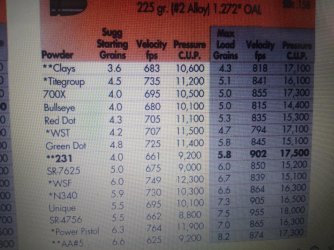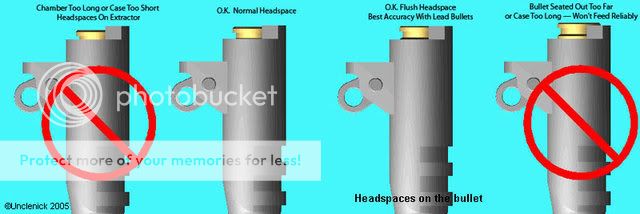Old_Me
Emissary
Bullseye powderThis post will be very figurative only because I'm really not absolutely sure of your recipe for your 45's, so I'm guessing at best on some things and don't want to steer you wrong.
Earlier most of what I took from what you wrote seemed to be leaning more to frangible bullets than to cast lead but up to this point wasn't a real issue. I wasn't quite sure why it seemed that way, but up till now I didn't see any real issues. But now you've entered a number which I believe to be a 'Min OAL' which in some cases is a critical measurement.
Building a too short cartridge is indicative of possible too high pressures. In your/this case it probably won't be an issue due to your stating the starting charge of 3.0grs of powder, but we don't know what powder you're using as far as I can recall. Remember, different powders can/will/do produce different pressure curves when ignited.
So, accepting you're using the minimum starting load for your particular powder in your chosen cartridge (45 Auto), and that the majority of loads shown in most of my literature for the 230 gr lead bullet show min OAL of around 1.200", and the .001" in question is probably due to measuring error, and that the majority of loads we're discussing are on the lower end of pressure ratings, you will probably be OK.
Please keep in mind I'm not advising you to go ahead and shoot them, just my best guess based on info I have. Me personally, I would pull them and reload them just to be sure. Remember, I told you I was a remnant/left over from many years of competition reloading and always strive for the 'inth' degree of consistency as well as safety. And finally, I'd appreciate your providing us a complete recipe of the load you're using. You may have provided it over time, but I don't seem to have the whole thing.
In the meantime, be careful, be sure, and be safe in your loading and your shooting.
all the cartridges, plunk test great, both in the gauge block, and the barrel.
all the cartridges, "turn" in the barrel as well.
that one that is "shorter" 1.209, i measured it several times, as i do all my cartridges.
i just do not know why that one came out that short, unless i used "too much" pulling on the handle, which try not to, but then again, as on the Dillon, i did not use "enough" pulling on the handle, and the bullets did not seat perfectly.
it's something i gotta learn to do the same way each time, on each press.
thanks, and no, i will not be competing against anyone or any clock
strictly target/plinking shooting.
if i got time today, i may pull that 1 bullet apart, and re-do it. but i may want to re-adjust all the dies on that Lee first.
i was sure when i had set it up weeks ago, i had them all dialed in, except the powder drop, which i did last, as i took several measurements, and plunk tests.
thanks again.


